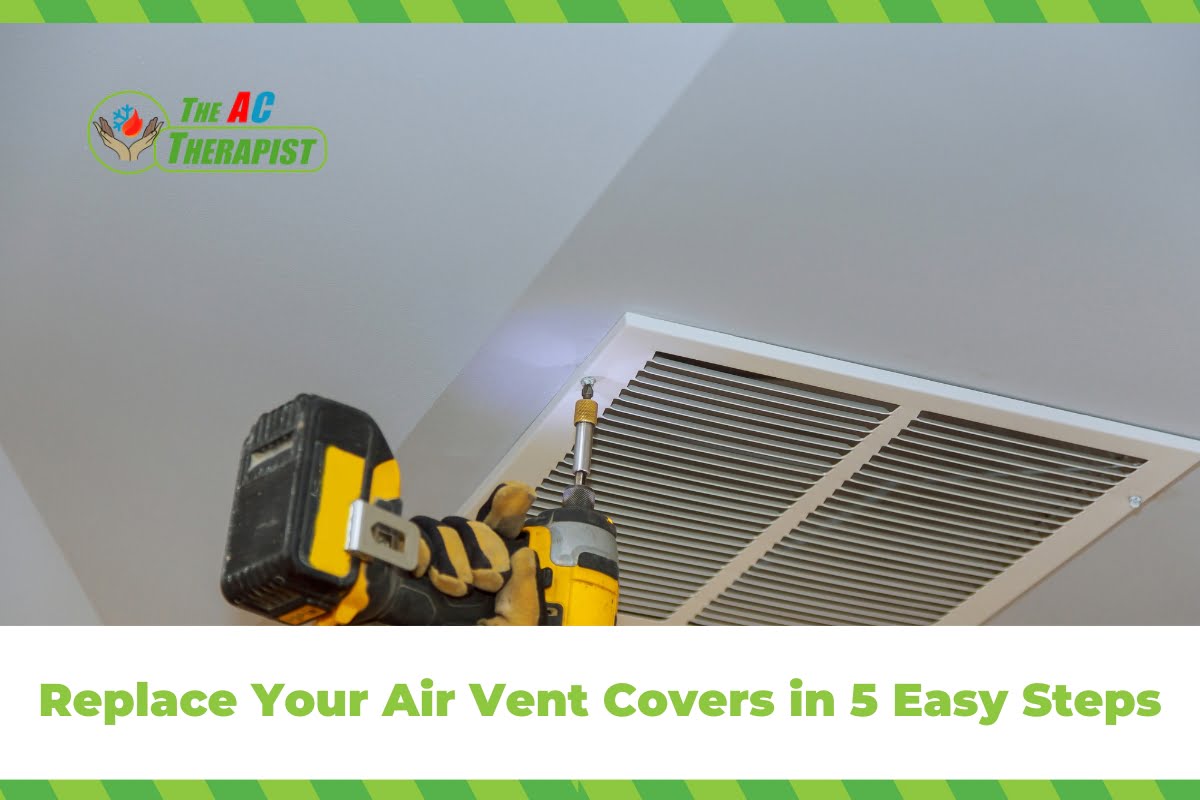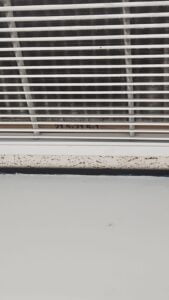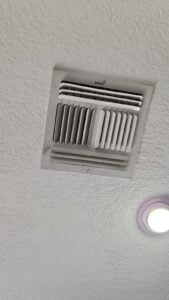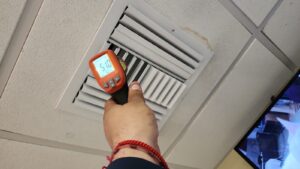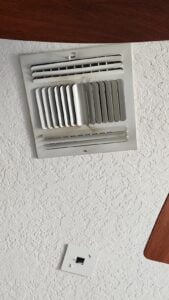Replace Your Air Vent Covers in 5 Easy Steps
Welcome to our comprehensive guide on air vent covers, an essential yet often overlooked component of your home’s heating, ventilation, and air conditioning (HVAC) system. While they might seem like mere decorative elements at first glance, air vent covers play a pivotal role in ensuring the efficiency and effectiveness of your HVAC system, contributing significantly to your home’s comfort, air quality, and overall aesthetic appeal.
In this blog, we’ll delve deep into the world of air vent covers, exploring their various types, purposes, and the impact they have on your living environment. Whether you’re undertaking a home renovation, looking to improve your HVAC efficiency, or simply curious about how you can enhance your interior design, understanding the significance of air vent covers is a great place to start.
From the basics of what air vent covers are and why they matter, to a detailed look at the different materials, designs, and features available, we aim to provide you with all the information you need to make informed decisions about this crucial aspect of your home’s ventilation system. We’ll also offer practical advice on how to select, maintain, and even replace your air vent covers to improve airflow, filter out debris, and add a touch of style to every room.
So, whether you’re a seasoned DIY enthusiast, a professional contractor, or a homeowner looking to spruce up your space, join us as we uncover everything there is to know about air vent covers. Let’s embark on this journey together to ensure your home not only looks good but also promotes a healthy, comfortable, and energy-efficient living environment.
Understanding Air Vent Covers
Understanding air vent covers is essential for maintaining a comfortable, efficient, and healthy living environment. These components, often overlooked, play a significant role in your home’s heating, ventilation, and air conditioning (HVAC) system. By covering the openings where the air is delivered or returned to your HVAC equipment, vent covers contribute to the system’s proper functioning and affect airflow, air quality, and even the energy efficiency of your home. This article delves into the purposes, types, and benefits of air vent covers, offering insights on how to select and maintain them for optimal performance.
Purpose of Air Vent Covers
Air vent covers serve several key purposes in a residential HVAC system:
- Airflow Control: They help direct and regulate the flow of air into and out of a room, contributing to consistent temperature distribution and comfort.
- Debris Filtering: Vent covers can prevent dust, pet hair, and other debris from entering the air ducts, reducing the amount of particulate matter circulated throughout your home.
- Aesthetic Appeal: Vent covers come in various designs and materials, allowing homeowners to choose options that complement their home decor.
- Safety: They cover duct openings, preventing small objects, pets, or children from accessing the ductwork.
Benefits of Air Vent Covers
Air vent covers, while seemingly simple components of a home’s HVAC system, offer a variety of benefits that extend beyond just covering duct openings. These benefits range from improved energy efficiency and air quality to enhanced interior aesthetics. Understanding these advantages can help homeowners appreciate the value of selecting the right vent covers and maintaining them properly. Here are some of the key benefits of air vent covers:
1. Improved Airflow Management
Air vent covers with adjustable louvers allow homeowners to control the direction and volume of airflow within a room. This capability enables more efficient heating and cooling, ensuring that air is distributed evenly throughout the space, and enhancing comfort levels.
2. Enhanced Energy Efficiency
By facilitating better airflow management, air vent covers can contribute to the overall energy efficiency of a home. Properly directed air means heating and cooling systems don’t have to work as hard to maintain desired temperatures, leading to lower energy consumption and reduced utility bills.
3. Protection Against Debris
Vent covers act as a barrier, preventing dust, dirt, and other debris from entering the HVAC system through duct openings. This not only helps maintain cleaner air within the home but also protects the HVAC system from potential damage caused by foreign objects, potentially extending its lifespan.
4. Improved Indoor Air Quality
By reducing the amount of dust and debris that can enter the HVAC system, air vent covers play a crucial role in improving indoor air quality. This is particularly beneficial for individuals with allergies, asthma, or other respiratory issues, as it helps minimize the irritants and allergens circulating in the air.
5. Enhanced Safety
Floor vent covers, especially, add a layer of safety by covering openings that could otherwise pose tripping hazards or allow small objects, pets, or even children’s fingers to enter the ductwork. Choosing the right vent covers can help prevent accidents and ensure a safer living environment.
6. Aesthetic Appeal
With a wide range of materials, designs, and finishes available, air vent covers offer significant aesthetic flexibility. They can be chosen to complement the home’s interior design, acting as decorative elements that enhance the overall look of a room rather than detracting from it.
7. Reduced Noise
Certain types of air vent covers are designed to minimize noise as air passes through them, contributing to a quieter, more peaceful home environment. This is particularly valuable in bedrooms, home offices, and other spaces where noise reduction is desirable.
8. Cost-Effective Update
Replacing or upgrading air vent covers is a relatively inexpensive way to make a noticeable improvement in both the function and style of a home. It’s a cost-effective home improvement project that can have a significant impact without the need for a major renovation.
Types of Air Vent Covers
Air vent covers come in various types, each suited to specific applications within the HVAC system:
- Supply Vent Covers: These cover the vents that blow air into rooms, usually featuring adjustable louvers for airflow direction control.
- Return Vent Covers: These covers are for return vents, where air is pulled back into the HVAC system for heating or cooling. They typically have larger openings and no louvers since their primary purpose is to allow unrestricted airflow back to the system.
- Decorative Vent Covers: Designed more for aesthetics than functionality, decorative vent covers can match any interior design style, from modern to traditional.
- Material Varieties: Vent covers are made from materials like metal, wood, plastic, and even custom materials for specific decor needs.
Selecting Air Vent Covers
When choosing air vent covers, consider the following factors:
- Size and Fit: Measure the duct opening accurately to ensure the vent cover fits properly. Improper sizing can lead to inefficiency and discomfort.
- Material: The choice of material can impact durability, aesthetics, and price. Metal covers are durable and ideal for high-traffic areas, while wood and plastic offer unique styles but may require more maintenance.
- Design and Features: Consider vent covers with adjustable louvers for supply vents to control airflow direction. For return vents, choose designs that promote unobstructed air return to the HVAC system.
- Energy Efficiency: Ensure the vent covers do not significantly restrict airflow, as this can force your HVAC system to work harder, increasing energy costs.
Preparing for Replacement
Tools and Materials Needed
- Screwdriver
- Measuring tape
- New air vent covers
- Level (optional)
Replacing air vent covers is a straightforward process that can significantly improve the appearance and efficiency of your home’s heating, ventilation, and air conditioning (HVAC) system. Whether your current vent covers are outdated, damaged, or simply don’t match your home’s decor, swapping them out for new ones is a simple yet effective home improvement project. Below is a detailed guide on how to replace air vent covers, along with some tips to ensure you select the right covers for your needs.
Step 1: Measure Your Existing Vent Covers
Before purchasing new vent covers, you’ll need to know the size of the ones you’re replacing. Use a tape measure to determine the length and width of the current covers. It’s important to measure the opening in the floor, wall, or ceiling, rather than the cover itself, to ensure a proper fit.
Step 2: Selecting New Vent Covers
When choosing new vent covers, consider both aesthetics and functionality. Vent covers come in various materials, including metal, wood, and plastic, and a range of styles to match any decor. Additionally, some vent covers offer features like adjustable louvers for controlling airflow or magnetic attachments for easy removal and cleaning.
Step 3: Removing Old Vent Covers
Most vent covers are attached with screws, so you’ll likely need a screwdriver to remove them. If the covers are painted over, you might need to carefully score around them with a utility knife to prevent damage to the wall or ceiling. For floor vents, some models simply drop into place and can be pried up with a flat tool.
Step 4: Cleaning the Duct Opening
With the old covers removed, take the opportunity to clean out the duct opening. Removing dust, pet hair, and other debris can improve air quality and HVAC efficiency. A vacuum with a hose attachment works well for this task.
Step 5: Installing the New Vent Covers
Place the new vent cover over the opening, making sure it fits snugly. If the new cover uses screws for attachment, align the holes with those in the duct opening and secure the cover in place. For drop-in models, simply press the cover into the opening until it sits flush with the floor, wall, or ceiling.
Additional Tips for Choosing and Replacing Vent Covers
When it comes to choosing and replacing air vent covers, several additional tips can help ensure you make the best decision for both aesthetics and functionality. These covers not only play a crucial role in your home’s ventilation system but also contribute to its overall look and feel. Here are some extra tips to consider:
1. Consider the Room’s Specific Needs
- Airflow Requirements: Different rooms may have different airflow needs based on their size, use, and location in your home. Bedrooms might require adjustable vent covers to control airflow for comfort during sleep, while living areas might benefit from more open designs to maximize air circulation.
2. Match the Decor
- Style Consistency: Ensure the vent covers match or complement the room’s existing decor and finish. For example, a modern minimalist home might look best with sleek, simple vent covers, while a more traditional home might benefit from decorative designs.
- Finish and Color: Vent covers come in various finishes and colors. Choose ones that either match your current decor or provide a pleasing contrast.
3. Energy Efficiency
- Sealing and Insulation: Some vent covers come with features that improve energy efficiency, such as better sealing against drafts or built-in insulation. These can be particularly useful in rooms that are harder to keep at a comfortable temperature.
4. Ease of Maintenance
- Removability: Consider how easy it is to remove and clean the vent covers. Magnetic vent covers, for example, are much easier to remove for cleaning than those that require unscrewing.
- Material: The material of the vent cover can affect how easy it is to clean and maintain. Metal and plastic covers are often easier to clean than wood.
5. Installation Considerations
- DIY Friendliness: If you plan to install the vent covers yourself, consider how easy they are to install. Some may require no tools at all, while others might need specific tools or a higher level of DIY skill.
- Compatibility: Ensure the new vent covers are compatible with your existing vent openings and ductwork. This includes not only the size but also the attachment method.
6. Health and Safety
- Material Safety: Be cautious of materials that might off-gas or contribute to poor indoor air quality. Non-toxic and eco-friendly materials can be a healthier choice, especially in bedrooms and children’s rooms.
- Protective Features: For floor vents in particular, consider covers with small enough openings to prevent small objects, pet toys, or even fingers from getting into the ducts.
7. Professional Advice
- Consultation: If unsure, consider consulting with an HVAC professional or interior designer. They can provide personalized advice based on your home’s specific needs and aesthetics.
8. Future Proofing
- Adaptability: Consider if the style and function of the vent covers will remain suitable for future renovations or decor changes. Choosing more neutral designs may offer greater longevity in terms of style.
By keeping these additional tips in mind, you can choose and replace vent covers that not only look great but also enhance the comfort, efficiency, and safety of your home.
Maintenance Tips for Air Vent Covers
Maintaining your air vent covers is crucial for ensuring the efficiency of your HVAC system, improving indoor air quality, and maintaining the aesthetic appeal of your home. Proper care prevents the buildup of dust and debris, which can obstruct airflow and circulate allergens. Here are essential maintenance tips for keeping your air vent covers in top condition:
1. Regular Cleaning
- Frequency: Clean your vent covers at least twice a year, ideally during the spring and fall, or more frequently in homes with pets, allergies, or high dust levels.
- Method: For most vent covers, vacuuming with a brush attachment will remove loose dust. For a deeper clean, wash them with warm, soapy water, but ensure they are completely dry before reinstalling. Metal and plastic covers can handle water cleaning, but wooden ones may require special care to avoid warping or damage.
2. Check for and Address Blockages
- Inspection: Occasionally remove the vent covers and use a flashlight to look into the ductwork for any blockages or significant dust buildup.
- Clearing Blockages: If you find blockages you can easily reach, carefully remove them. For deeper issues, consider hiring a professional duct cleaning service.
3. Ensure Proper Fit and Installation
- Tightness: Loose vent covers can rattle and may not efficiently direct airflow. Ensure they are securely fastened to the wall, ceiling, or floor.
- Sealing Gaps: If there are gaps around the edges of the vent covers, consider using caulk or weather stripping to seal them, preventing air leaks and improving energy efficiency.
4. Periodic Inspections for Damage
- Wear and Tear: Regularly inspect your vent covers for signs of damage, such as cracks, bends, or rust. Damaged covers can impair airflow and detract from the appearance of your room.
- Replacement: If a vent cover is damaged or beyond cleaning, replacing it is often the best option to maintain air quality and efficiency.
5. Adjust for Seasonal Changes
- Airflow Direction: Some vent covers come with adjustable louvers that allow you to direct airflow. In the winter, direct warm air towards the center of the room; in the summer, direct cool air upwards to distribute it evenly.
6. Consider Professional Cleaning for Ductwork
- Professional Assessment: While cleaning vent covers is a great DIY task, the ductwork behind them might need professional attention, especially if you notice mold, pests, or significant dust buildup.
- Scheduling Professional Cleaning: HVAC professionals recommend duct cleaning every 3 to 5 years, but this can vary based on your home’s specific needs and conditions.
7. Be Mindful of Paint
- Painting Vent Covers: If you decide to paint your vent covers for aesthetic reasons, ensure you use paint that is suitable for the material and does not obstruct any moving parts, like adjustable louvers.
By following these maintenance tips, you can significantly contribute to the longevity of your HVAC system, enhance indoor air quality, and keep your home looking its best. Regular attention to your air vent covers is a small but critical part of home maintenance that offers significant benefits.
Breathe Easy and Live Beautifully: The AC Therapist’s Guide to Air Vent Covers
At The AC Therapist, we understand the profound impact that seemingly minor elements, like air vent covers, can have on the overall health, comfort, and beauty of your home. Through this guide, we’ve explored the essential roles that air vent covers play in enhancing airflow management, improving energy efficiency, safeguarding against debris, and elevating indoor air quality. Moreover, we’ve highlighted their contribution to your living space’s aesthetic appeal and safety, underscoring their significance beyond mere functionality.
Choosing the right air vent covers, with their myriad designs and materials, offers an opportunity to complement your home’s decor while achieving optimal HVAC efficiency and air quality. This blend of functionality and style ensures that your living environment not only supports your health but also reflects your taste.
Remember, maintenance is key. Regular cleaning and inspection of your vent covers can prevent airflow obstruction and maintain the efficiency of your HVAC system, contributing to a comfortable, safe, and energy-efficient home. As your dedicated partner in home comfort, we at The AC Therapist are here to provide advice, services, and solutions tailored to your unique needs, ensuring that every aspect of your HVAC system, down to the smallest detail like air vent covers, is optimized for your well-being and satisfaction.
In closing, let air vent covers serve as a reminder of the importance of attention to detail in creating a comfortable, efficient, and stylish home environment. Embrace the opportunity to enhance your home’s health, aesthetics, and overall comfort with the right choice of air vent covers. As always, The AC Therapist is here to guide you through every step of the process, ensuring your home remains a haven of comfort and style.

